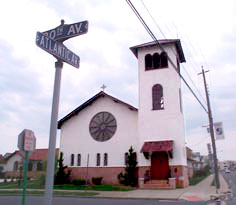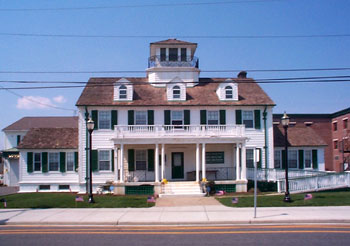History of Longport
Longport is located on the southern tip of Absecon Island, the borough encompasses approximately half of a square mile of land area and is bordered by the bay on the northwestern coast and the ocean on the southeastern coast.
Historic Church of the Redeemer
According to local historian and Mayor Michael Cohen, in his book “Longport- The Way We Were,” the first recorded private landowner was Thomas Budd, who settled a claim against the Lord Proprietors of New Jersey in 1695. In the claim, he was awarded 1,500 acres of land, of which a large portion was located on Absecon Island. He later sold most of the property at cost of four cents an acre.
Years later, in 1854, Samuel Overshine purchased a parcel of land containing dunes that built-up at the southwestern end of the island for $130. That same year he sold a parcel of that land for $10 to Isaac Barton. Three years later, Barton traded what was known as Lot 32 for a total of $2,000 plus land in Arkansas to James Long.
Long kept the property for 25 years and over the years, his property value increased in both value and size. His property increased by a little more than a mile in length after accumulating sand from an erosion updrift from Atlantic City between 1870 and 1880. He never came to see the land he purchased, nor did he decide to develop it. Although, he came back to Longport several years later and purchased an entire block of land, between 12th and 13th avenues, where he built a home on the beach. Long named it the “Bide-A-Wee.” By the turn of the century, the home was sold and became a sanatorium. The building was destroyed by a storm in 1914.
Long decided to sell Lot 32 to his friend M. Simpson McCullough in 1882. McCullough, a renowned Philadelphia lawyer, businessman, developer and builder, thought of developing the area into a “seashore resort.”
Longport Museum
McCullough purchased the area, which had increased to a size of 250 acres for a total of $150,000. He then decided to name the area “Longport” in honor of the previous parcel owner and his friend. The naturally long port on the bay side also contributed to McCullough’s decision in names.
Longport became a good deal shorter between the years of 1900 and 1916, when approximately 180 acres of the 250 that McCullough purchased, moved across the inlet and became what is known as the Ocean City Gardens. This explains why the first avenue of the borough starts at 11th, instead of first, as avenues one through 10 were lost during those years. He began to sell the lots in 1882.
The early years of the town were far more commercial, compared to today. Now the composition of the town is mostly residential. In the last three years, Longport said goodbye to two of its landmarks. The first was the demolition of Gospel Hall in the year 2000 and the second was the Longport Inn.
In 1911, Peter A. B. Widener purchased beachfront property between 28th and 29th avenues in Longport. In this space of land he built the Widener Industrial School as a “Summer Seashore Home for Handicapped Children.” Severely handicapped children were provided with a rigid schedule of rehabilitation at the school. When it opened, approximately 54 percent of the children had infantile paralysis and 36 percent were afflicted with tuberculosis of the spine.
The school was later re-named the Widener Memorial School, shortly after Widener’s son, George Dunton Widener and his grandson Harry Elkins Widener, died in the sinking of the Titanic. Over time, as treatment changed for handicapped children, enrollment began to decline at the Widener School.
During World War I the building was used to treat soldiers and was vacated again in 1941 to allow the Armed Services to train on the beach in the back of the building.
In 1944 the Widener School building was purchased by William J. Bates who also owned the Canterbury Hall and the Winchester Hotel. He converted the building into his third hotel, known as the Essex Beach Club. It remained as a hotel until sold to The Gospel Hall Home for the Aged in 1949. It remained as the Gospel Hall until its recent demolition. The property is now home to 12 beach block homes known as the Widener Reserve.
The Longport Log Cabin Inn was built in 1915. It was built by Jim and Rose Julian. Ownership of the restaurant had changed hands several times before its demolition in 2001. The vacant site has been zoned for several single-family homes.
The town’s first Borough Hall was once home to the town Society of Natural Sciences. After the borough’s incorporation in 1898, the town bought the society’s building for $4,750. A new brick first floor was built for the building in 1900. The old building was set upon this new brick foundation. It served as the town’s first Borough Hall until 1944. The United States Coast Guard Building, currently the Longport Historical Society Museum, served as Longport’s second Borough Hall until 1990. The third and current Borough Hall building was originally built in 1924 as the Betty Bachrach Home for Afflicted Children.
The United States Coast Guard building was constructed in 1849, between 32nd and 34th avenues. A second building was built in 1900 on the oceanside corner of 23rd and Atlantic avenues. The building was then moved in 1912 across Atlantic Avenue to the bay side, where the current Longport Historical Society Museum now sits. This building was destroyed by termites.
The Betty Bacharach Home for Afflicted Children was founded by, two brothers, United States Congressman Isaac Bacharach and Mayor of Atlantic City Harry Bacharach in honor of their mother. The building opened on Mother’s Day in 1924. By the mid 1940s the Bacharach Home attained national recognition as a convalescent center for children. It was also considered as one of the best-equipped institutions in the east for treatment and care of those diagnosed with infantile paralysis. The institution could care for 125 children. In 1975, the facility had moved to Pomona and the building was then leased to the Winchell Orthopedic School. The Winchell School later moved to Northfield in 1987. In 1987, the building was purchased by the borough for use as a borough hall. By 1990, remodeling was complete and offices moved into the building. The Police Department moved into the new Borough Hall a year later.
The Borough of Longport has a vast history and many stories to offer. Those interested in more information would benefit from a trip to the Longport Historical Society and Museum located next to Borough Hall at 2301 Atlantic Avenue in Longport. The museum is open during the summer season on Saturdays from 9 a.m. until noon. The Longport Historical Society can be reached by dialing 609-823-1115.




